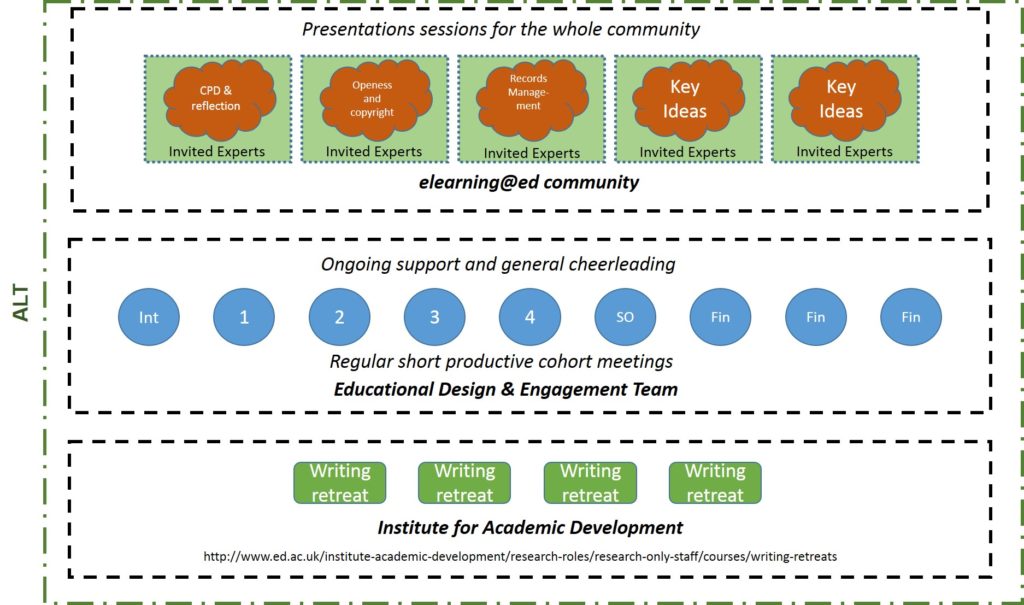Much of my work over the last 10 years has focused on bringing staff at the Uof E together around areas of common interest and supporting and encouraging them to learn together. I set up institutional user groups for the Online Distance Learning Community, the Learn User Group and Virtual Classroom/Meeting User Group.
I was influenced by the concept “Communities of Practice (CoP)” as described by Wenger, E. (1998) whose work I read when I was studying for my PGCert in Professional Education and which I realise, has influenced my practice ever since. Wenger, E. (1998) describes how groups of people working on an area of shared interest are brought together as a community working towards a shared goal and how this community can develop it’s own ways of working and supporting new members. My understanding from this is that you can’t ‘make’ a CoP – this develops from the shared common interest. However you can ‘nurture’ a group that is forming around an area of interest.
Undertaking CMALT can be an individual endeavour but we decided to use the cohort approach as this encourages the formation of supportive networks. These connections take a variety of forms:
- Connecting different roles, for example administrative, teaching and support staff – to enable the observation of cultural working practices.
- Building relationships across various models of support e.g. centrally and locally deployed services – to negotiate mutual understanding of experience.
- Providing role models for staff new to the institution and/or to learning technology – to support legitimate peripheral participation.
- By providing visible, funded, CPD support for Learning Technology staff it is hoped to retain talent and to attract people to the University, as the destination of choice for staff with learning technology skills – creating legitimate space for participation and supporting community growth.
The idea is that in this workplace context, participants are much more likely to make connections between the theory and their situated practice, and to be able to action change in their practice.
Supporting the CMALT cohort

This diagram show the model of support I use comprised of regular meetings (f2f and webinars) and half day writing retreats (organised with support from the Institute for Academic Development) for cohort members. I also organised open events on ‘Key Issues’ – these are areas relevant beyond the CMALT cohort and part of the rationale for holding them is to encourage professional networking and building relationships across the University.
I send out evaluation surveys after every session and was interested to get mixed feedback for some of the elements. The writing retreats where regarded as really helpful for the majority of the group but a couple of participants really disliked this format – “why would I come to the University to sit in silence when I could do this at home” said one (who had a long journey onto the campus) unimpressed by the community aspect so valued by others in the group.

In the first group one participant attend none of the offered meetings after the initial introductory session and still successfully submitted their portfolio at the next assessment window. I was surprised because its so different from my own approach! I like working with a group so I was assuming everyone did. I’ve come to accept that not everyone learns in the same way or approaches the same task in the same way. This is something I ‘knew’ in terms of theory but didn’t enact in terms of the way I approach my practice. I realise that I hold an assumption that other people like to learn in the same way that I do:
- Little and often
- Small chunks
- Find discussion helpful for forming ideas
On reflection, it may not have been that the applicant didn’t want to be part of a CoP but rather they were already part of a well established group in their own subject area, which is based on a different campus. They were not looking for support and as an experienced member of staff may not have wanted to provide this to less experienced staff in the group.
I was surprised that a large number of my cohort have not yet completed their portfolios – in the first year there were 23 applicants, with 11 in the second year. So far 13 have successfully completed, 1 has failed and 3 have withdrawn. This leaves 17 participants who have yet to make a submission. Several have had to deal with unforeseen challenges, job changes, health issues or additional care responsibilities. Initially it really surprised that people without a high level of commitment to following it through. Though after discussion with my mentor, I realise its possible that they may just have had unrealistic expectations of what CMALT entailed.
References
Wenger, E. (1998). Communities of practice: Learning, meaning and
identity. Cambridge, UK: Cambridge University Press.